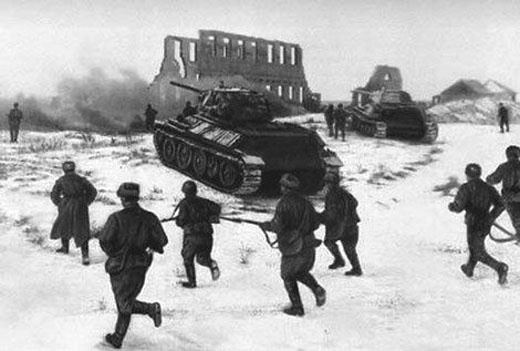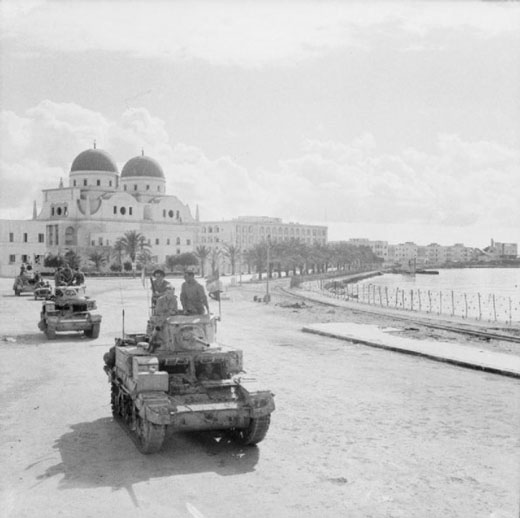Air Operations, Europe
BOMBER COMMANDEvening Ops:
- 11 Wellingtons of 1 Group lay mines off Lorient and St Nazaire.
- 1 Wellington is lost.
Air Operations, Tunisia
B-17s ot the 97th Heavy Bomb Group's 340th Heavy Bomb Squadron, escorted by 14th Fighter Group P-38s, attack Tunis/El Aouina Airdrome, destroying 8 Axis aircraft on the ground.
[Battle of the Atlantic
Adm Horton takes over the British Western Approaches Command from Adm Noble. Although Noble has been an able leader, he does not have the forceful spirit which Horton brings to the job. The German U-boat leaders soon notice the change. Dönitz will write later that Horton's appointment made a substantial difference.
[Eastern Front
The Soviet winter offensive, called Operation URANUS, begins along the Don. The German forces throughout the southern Soviet Union are hopelessly overextended. Stalingrad has drawn German troops like moths to a candle while both to their left and right are unreliable allies. The Soviets have been planning a grand attack with fresh divisions for weeks. They intend a pincer move with armies from the Southwest Front, under Vatutin, and the Don Front, under Rokossovsky, attacking southward from the Don, especially between Kletskaya and Kotovskiy, and the Stalingrad Front, under Yeremenko, whose armies are to attack from south of the city. Zhukov is in overall command. Only the northern claw of the pincer attacks at this stage. The Soviets have assembled more than 500,000 infantry, 900 new T34 tanks, and have the support of masses of artillery and over 1,000 attack planes. The units deployed in the northern pincer are 5th Tank Army, 21st Army and parts of 1st Guards Army. The unfortunate victims are 7 divisions of the Rumanian 3rd Army who come under murderous pressure and can do little to prevent a major breakthrough around Kletskaya.
Russian Troops Counterattack |
 |
At 8:50a.m., after a murderous artillery preparation, the Russians launch their great counteroffensive at Stalingrad. For the Germans this is the beginning of a colossal disaster. 6 corps of the Don Front move from the Kletskaya bridgehead beyond the Don, 75 miles northwest of Stalingrad. Further north the armies of the Southwest Front are advancing from Serafimovich on the Don, about 95 miles northwest of Stalingrad. The Germans and Rumanians hold out fairly well everywhere, except that a powerful Russian penetration is immediately reported in the Kletskaya area. Von Weichs, commanding Army Group B, orders an immediate counterattack, but all that results is temporary containment of the enemy.
In the Caucasus the Germans are in trouble also. The Soviets win an important engagement near Ordzhonikidze. Bad weather largely ends major operations here but the Soviets manage a series of small gains in the next few weeks.
SOUTHERN SECTOROperation URANUS begins as the Southwestern and Don Fronts attack the Romanian 3rd Army. The Romanians defend stoutly and at first the Soviet 5th Tank, 21st and 65th Armies make slow progress. However, an assault by the I and XXVI Tank Corps of the 5th Tank Army eventually rips a hole in the Romanian front, through which the Soviets pour. By the end of the day the Romanians have suffered a staggering 55,000 casualties. The German XLVIII Panzer Corps is ordered to restore the situation, but attacks by the Romanain 1st Armored Div north of Zhirkovski and 22nd Panzer Div frm Peschany are costly failures. Paulus, ordered to restore his northern flank, decides to employ his three panzer divisions.[MORE]
[Guadalcanal
The 1st Battalion, 182nd Infantry, under Lt-Col Francis F. MacGowan, crosses the Matanikau and advances along flat ground between the northernmost hills and the beach, while B Company, 8th Marines, advances over the most northerly hill (Hill 78) to cover the battalion's left flank. About 400 yards west of the river the battalion meets fire from small enemy groups but continues its slow movement toward Point Cruz. About noon the battalion halts just east of Point Cruz, digs in along 700-yard line from the beach east of the point to the west tip of Hill 78. B Company withdraws back across the river to rejoin its regiment. The 1st and 2nd Battalions of the 182nd Infantry are separated by a gap of over 1,000 yards. During the night the Japanese move forward from Kokumbona and open fire on the 1st Battalion.
[New Guinea
Forward elements of the Australian 25th Brigade encounter the enemy one mile south of Gona. The Australian 16th Brigade makes contact with the Japanese just outside Soputa. After establishing contact with the Australians near Popondetta, the 126th Infantry, US 32nd Division, heads for Buna but, since the Japanese appear to be concentrated west of the Girua River, is directed to assist Maj-Gen George A. Vasey's Australian 7th Division instead. Gen Harding thus loses half his assault force, exposing the left flank of Warren Force. The 1st and 3rd Battalions of the 128th Infantry, Warren Force, attack in parallel columns, the 1st Battalion from Boero and the 3rd Battalion from Simemi. Both run into acurate enemy fire from concealed positions and suffer heavy casualties. A maximum gain of 200 yards is made on the right along the coast.
[North Africa
LIBYAThe British 8th Army enters Benghazi.
Stuart Tanks in Benghazi |
 |
British paratroopers advancing from Souk-el-Arba encounter Germans at Sidi Nzir, southwest of Bizerta.
Gen Louis Jacques Barré of the French XIX Corps rejects a German ultimatum that they abandon Medjez el Bab as they continue to resist German attacks. During the day the French troops are reinforced by the British and Americans. The Germans, now led by Gen Nehring, have brought forward tanks and infantry, but are forced to retire in the face of the reinforced Allies. Gen Barré openly joins the Allies.
[